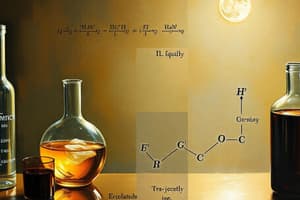Podcast
Questions and Answers
What is a chemical equation?
What is a chemical equation?
An equation that represents, with symbols and formulas, the identities and relative molecular or molar amounts of the reactants and products in a chemical reaction.
The evolution of heat and light is not an indication of a chemical reaction.
The evolution of heat and light is not an indication of a chemical reaction.
False (B)
What is a precipitate?
What is a precipitate?
A solid that is produced as a result of a chemical reaction in solution and that separates from the solution.
Which of the following are characteristics of chemical equations? (Select all that apply)
Which of the following are characteristics of chemical equations? (Select all that apply)
What does a coefficient represent in a chemical equation?
What does a coefficient represent in a chemical equation?
What is a word equation?
What is a word equation?
What symbol indicates that reactants yield products in a chemical equation?
What symbol indicates that reactants yield products in a chemical equation?
Name two examples of diatomic molecules.
Name two examples of diatomic molecules.
What is the process of balancing an equation?
What is the process of balancing an equation?
A balanced formula equation has the same number of atoms of each element on both sides.
A balanced formula equation has the same number of atoms of each element on both sides.
What does the symbol (s) represent in a chemical equation?
What does the symbol (s) represent in a chemical equation?
What does a catalyst do in a chemical reaction?
What does a catalyst do in a chemical reaction?
What is a synthesis reaction?
What is a synthesis reaction?
What characterizes a decomposition reaction?
What characterizes a decomposition reaction?
Define electrolysis.
Define electrolysis.
What does a double-displacement reaction involve?
What does a double-displacement reaction involve?
What type of reaction releases energy in the form of light and heat?
What type of reaction releases energy in the form of light and heat?
Flashcards are hidden until you start studying
Study Notes
Chemical Equations
- A chemical equation uses symbols and formulas to represent reactants and products in a reaction.
- It must depict known facts, ensuring all reactants and products are identified correctly.
Indications of a Chemical Reaction
- Signs include the release of energy (heat and light), production of gas, formation of a precipitate, and color changes.
Precipitate
- A precipitate is a solid that forms from a chemical reaction in a solution and separates from the liquid.
Characteristics of Chemical Equations
- Recognize the importance of correct formulas for each substance.
- The law of conservation of mass dictates that the same number of each type of atom must be present on both sides of the equation.
Coefficient
- A coefficient is a whole number in front of a formula in a chemical equation, indicating the relative number of moles; if absent, it is understood to be one.
Types of Equations
- A word equation expresses reactants and products in word form.
- A formula equation represents them by their chemical symbols.
Reaction Symbols
- The arrow (→) indicates that reactants yield products.
- A reversible reaction is depicted with two arrows (← →).
States of Matter in Reactions
- (s) denotes a solid, (l) a liquid, (aq) an aqueous solution, and (g) a gas.
- Symbols like ↓ and ↑ indicate the formation of a precipitate or gaseous products, respectively.
Catalysts and Reactions
- Catalysts are substances altering the reaction rate but remain unchanged. They are indicated in the equation, often over the reaction arrow.
- Electrolysis refers to decomposing a substance using electric current.
Types of Chemical Reactions
- Synthesis reaction: A + X → AX; two or more substances combine.
- Decomposition reaction: AX → A + X; a single compound breaks down.
- Single-displacement reaction: A + BX → AX + B; one element replaces another.
- Double-displacement reaction: AX + BY → AY + BX; ions exchange places in solution.
- Combustion reaction: Combines with oxygen, producing energy, often with water as a product.
Activity Series
- An activity series ranks elements by their reactivity, affecting how they replace each other in reactions. More active elements can replace less active ones in single-displacement reactions.
Balancing Chemical Equations
- Balancing involves adjusting coefficients to equalize the number of atoms of each element on both sides of the equation, maintaining the law of conservation of mass.
Important Notes
- Use coefficients for balancing; never alter subscripts.
- Adjust oxygen and hydrogen last when balancing reactions.
Studying That Suits You
Use AI to generate personalized quizzes and flashcards to suit your learning preferences.




